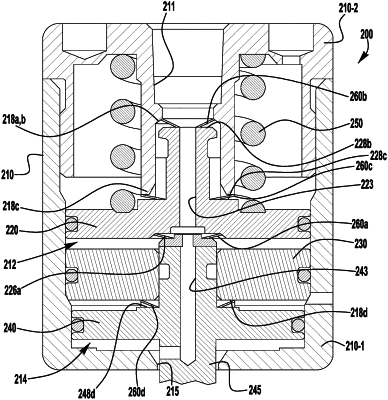| CPC F15B 15/226 (2013.01) [F16K 31/1221 (2013.01); F16K 31/1225 (2013.01); F16K 47/00 (2013.01)] | 18 Claims |

|
1. An actuated valve assembly comprising:
a valve including a valve body defining a flow path and a valve element axially movable to selectively control fluid flow through the valve flow path;
an actuator assembled with the valve, the actuator comprising:
a housing defining an inlet port;
a piston disposed within the housing, wherein the piston is operatively connected with the valve element for axial movement of the valve element between a closed position and a full flow position;
a return spring disposed within the housing and configured to apply a first biasing force to the piston to move the piston toward a spring return position corresponding to the closed position of the valve element; and
an elastically deformable element;
wherein a first fluid pressure applied to the inlet port moves the piston against the first biasing force of the return spring to a first actuated position corresponding to a partial flow position of the valve element, in which the piston indirectly engages a stop portion of the housing through at least the elastically deformable element;
wherein a second fluid pressure, greater than the first fluid pressure, applied to the inlet port moves the piston against a second biasing force of the elastically deformable element to compress the elastically deformable element and to move the piston to a second actuated position beyond the first actuated position and corresponding to the full flow position of the valve element; and
wherein the elastically deformable element has a spring rate at least 10 times a spring rate of the return spring, such that the elastically deformable element provides for predictable proportional incremental movement of the piston between the first actuated position and the second actuated position in response to incremental increases in fluid pressure applied to the inlet port between the first fluid pressure and the second fluid pressure; and
wherein application of the first fluid pressure to the inlet port moves the piston against the first biasing force of the return spring without compression of the elastically deformable element.
|